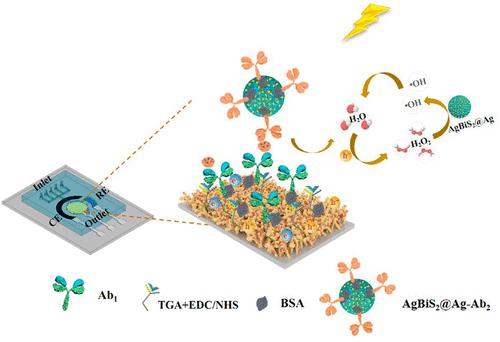当前位置:
X-MOL 学术
›
Anal. Chem.
›
论文详情
Our official English website, www.x-mol.net, welcomes your
feedback! (Note: you will need to create a separate account there.)
Catalytic Decomposition of the Hole-Derived H2O2 by AgBiS2@Ag Nanozyme to Enhance the Photocurrent of Z-Scheme BiVO4/ZnIn2S4 Photoelectrode in Microfluidic Immunosensing Platform
Analytical Chemistry ( IF 6.7 ) Pub Date : 2022-08-23 , DOI: 10.1021/acs.analchem.2c02181 Tingting Wu 1 , Xianzhen Song 1 , Xiang Ren 1 , Li Dai 1 , Hongmin Ma 1 , Dan Wu 1 , Yuyang Li 1 , Qin Wei 1 , Huangxian Ju 1, 2
Analytical Chemistry ( IF 6.7 ) Pub Date : 2022-08-23 , DOI: 10.1021/acs.analchem.2c02181 Tingting Wu 1 , Xianzhen Song 1 , Xiang Ren 1 , Li Dai 1 , Hongmin Ma 1 , Dan Wu 1 , Yuyang Li 1 , Qin Wei 1 , Huangxian Ju 1, 2
Affiliation

|
A novel microfluidic photoelectrochemical (PEC) analytical device based on AgBiS2@Ag nanozyme-mediated signal amplification was developed for ultrasensitive detection of cytokeratin 19 fragment 21–1 (CYFRA 21–1). First, a brand new Z-scheme BiVO4/ZnIn2S4 (BZIS) photoactive material was utilized as a sensing matrix to supply a stable photocurrent. Under anodic bias, the photoexcited holes in BiVO4 could oxidize water to produce hydrogen peroxide (H2O2), which markedly enhanced the separation efficiency of the electron–hole pairs. Besides, the Z-scheme heterojunction formed between BiVO4 and ZnIn2S4 further accelerated the transport of the electron. Second, for improving the sensitivity of the PEC sensor, a new strategy of catalytic dissociation of the hole-derived H2O2 by AgBiS2@Ag nanozyme was proposed to amplify the PEC signal. AgBiS2@Ag composites, possessing an excellent peroxidase-mimicking feature, could efficiently catalyze the H2O2 to produce hydroxyl radicals (•OH) and lead to the significant enhancement of the photocurrent. Third, automatic sample injection and detection were successfully realized by integrating the photoelectrode into microfluidic chips. Based on this advanced sensing strategy, the designed microfluidic PEC sensor displayed a wide linear range (0.1 pg/mL – 100 ng/mL) and a low detection limit of 35 fg/mL (S/N = 3), which could be efficiently applied to the ultrasensitive determination of CYFRA 21–1 in a human serum sample.
中文翻译:

AgBiS2@Ag 纳米酶催化分解空穴衍生的 H2O2 以增强微流体免疫传感平台中 Z 型 BiVO4/ZnIn2S4 光电极的光电流
开发了一种基于 AgBiS 2 @Ag 纳米酶介导的信号放大的新型微流控光电化学 (PEC) 分析装置,用于超灵敏检测细胞角蛋白 19 片段 21-1 (CYFRA 21-1)。首先,采用全新的Z型BiVO 4 /ZnIn 2 S 4 (BZIS)光敏材料作为传感矩阵,提供稳定的光电流。在阳极偏压下,BiVO 4中的光激发空穴可以氧化水产生过氧化氢(H 2 O 2),显着提高了电子-空穴对的分离效率。此外,BiVO 4和ZnIn 2 S之间形成了Z型异质结。4进一步加速了电子的传输。其次,为了提高PEC传感器的灵敏度,提出了一种利用AgBiS 2 @Ag纳米酶催化解离空穴衍生的H 2 O 2的新策略来放大PEC信号。AgBiS 2 @Ag 复合材料具有优异的过氧化物酶模拟特性,可有效催化 H 2 O 2产生羟基自由基(•OH) 并导致光电流显着增强。第三,通过将光电极集成到微流控芯片中,成功实现了自动进样和检测。基于这种先进的传感策略,所设计的微流控 PEC 传感器显示出较宽的线性范围(0.1 pg/mL – 100 ng/mL)和 35 fg/mL(S/N = 3)的低检测限,可以有效地应用于人血清样品中 CYFRA 21-1 的超灵敏测定。
更新日期:2022-08-23
中文翻译:

AgBiS2@Ag 纳米酶催化分解空穴衍生的 H2O2 以增强微流体免疫传感平台中 Z 型 BiVO4/ZnIn2S4 光电极的光电流
开发了一种基于 AgBiS 2 @Ag 纳米酶介导的信号放大的新型微流控光电化学 (PEC) 分析装置,用于超灵敏检测细胞角蛋白 19 片段 21-1 (CYFRA 21-1)。首先,采用全新的Z型BiVO 4 /ZnIn 2 S 4 (BZIS)光敏材料作为传感矩阵,提供稳定的光电流。在阳极偏压下,BiVO 4中的光激发空穴可以氧化水产生过氧化氢(H 2 O 2),显着提高了电子-空穴对的分离效率。此外,BiVO 4和ZnIn 2 S之间形成了Z型异质结。4进一步加速了电子的传输。其次,为了提高PEC传感器的灵敏度,提出了一种利用AgBiS 2 @Ag纳米酶催化解离空穴衍生的H 2 O 2的新策略来放大PEC信号。AgBiS 2 @Ag 复合材料具有优异的过氧化物酶模拟特性,可有效催化 H 2 O 2产生羟基自由基(•OH) 并导致光电流显着增强。第三,通过将光电极集成到微流控芯片中,成功实现了自动进样和检测。基于这种先进的传感策略,所设计的微流控 PEC 传感器显示出较宽的线性范围(0.1 pg/mL – 100 ng/mL)和 35 fg/mL(S/N = 3)的低检测限,可以有效地应用于人血清样品中 CYFRA 21-1 的超灵敏测定。









































 京公网安备 11010802027423号
京公网安备 11010802027423号